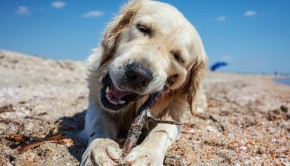Canine Hip Dysplasia: Treatment and Prevention
One of the most difficult tasks facing a veterinarian is how to manage hip dysplasia. There are several modes of therapy available, but only the most commonly accepted techniques will be discussed.
1. Maintenance: This is non-surgical management and consists of rest and restricted exercise, pain relievers, and anti-inflammatory drugs. Its best use is in mild cases or in dogs who are poor surgical risks.
2. Hip Join Reconstruction: This is extensive bone surgery with the ultimate goal of returning the hip joint to a normal anatomical relation. It is quite difficult to perform and often must be referred to an orthopedic surgeon. Surgery to correct hip dysplasia works best in young dogs before arthritis of the joint has become a problem. The techniques include pelvic osteotomy, acetabuloplasty, and varus osteotomy.
3. Joint Replacement: Older animals may benefit from surgery in this classification. The ‘ball’ part of the joint is either replaced with a synthetic ball or removed entirely. A synthetic replacement has not been very successful to date. Removal of the femoral head eliminates its bone contact with the pelvis and, eliminates the pain.
Prevention
Any disease with a hereditary component can be at least partially controlled by selective breeding and studies thus far have been very rewarding. A nonprofit organization, the Orthopedic Foundation For Animals (O.F.A.), has been engaged in the study of orthopedic diseases since 1966.
Their program for the control of dysplasia is centered on x-ray evaluation of the hips. Three independent veterinary radiologists interpret every film sent to the foundation. If the joints appear normal, an O.F.A. Certification number is given. If any degree of dysplasia is found, the owner and his veterinarian are notified. Dogs showing any degree of dysplasia should not be used for breeding.
Large-breed owners should insist on a radiographic evaluation of the hip joints of any dogs to be used for breeding, whether male or female. Anyone who has suffered from a growing pup afflicted with this crippling disease can appreciate the importance of this type of control program. It should be noted that the O.F.A. certified parents may produce dysplastic offspring, but the incidence is greatly reduced.
Since the treatment of hip dysplasia is far from satisfactory in many cases, restrictive breeding remains as our best weapon for exterminating this disease.






